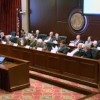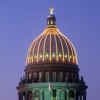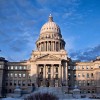Background
Each year, the 18-member bipartisan panel known as EORAC (Economic Outlook and Revenue Assessment Committee) meets for two days before the session begins. They listen to business leaders, economists, state officials and interest group leaders about the current state of the economy. Some of the information is highly data-driven, like the state’s quarterly tax collections. Some of the information is more anecdotal.
EORAC didn’t always go about its job the way it does today. In fact, prior to 1994, the committee didn’t exist at all. Instead, there was the Revenue Projections Committee. According to Mike Ferguson, Director of the Idaho Center for Fiscal Policy, that committee had a rigorous process for arriving at its own revenue projection. They held hearings and met with business leaders. “They literally went in and debated the specific revenue sources and the estimates they’d heard and likely revenues,” he said.
Former Division of Financial Management Director Marty Peterson agrees the committee’s forecasts were carefully computed. “They sat down and came up with a projection that had detail in it in terms of what they were expecting, in revenue, from each of the major tax categories,” he said.
Legislative Services Office Director Jeff Youtz remembers it slightly differently. He says the committee’s revenue estimate often didn’t align with the estimate produced by the governor’s office. The process of arriving at both numbers was, he says, highly political. “We had dueling numbers,” he said. “Partly because we had Democratic governors at that time and a Republican legislature, there were dueling revenue projections numbers.” He says there were often allegations, on both sides, of gaming the projections.
To get away from that politicized process, Youtz says, the Revenue Projections Committee was shelved in 1994. The Economic Outlook and Revenue Assessment Committee came into being, intended as the streamlined, impartial successor.
As it was originally established, EORAC’s purpose wasn’t to create its own revenue estimate, but to check the number produced by the governor’s office. “Their charge was to assess the governor’s revenue number — whether it was reasonable or not for the purpose of setting a budget,” Youtz said. For the most part, the committee signed off. Mission accomplished: a less partisan process.
But the Idaho Center for Fiscal Policy’s Ferguson says that’s no longer the way it works. “Over time, it’s evolved back toward creating a forecast,” he said, “but with a very different underlying methodology.” Youtz agrees. “They’ve kind of been evolving back the other way now, and I think what’s fed that is these crazy times the last few years,” Youtz said.
The big question is: How much does all of this matter? Actually, a great deal. Consider this, from the introduction to a Pew Center on the States and Nelson A. Rockefeller Institute of Government study published last year. “As state leaders enter the fourth year of the nation’s fiscal crisis, it has never been more important for them to use the best information possible when crafting their budgets,” the note to readers begins. “The state revenue estimates that inform these spending plans help drive policy decisions about whether to raise or reduce taxes, how much to spend on programs, and—increasingly—where and how much to cut.”
As the study (called “State’s Revenue Estimating: Cracks in the Crystal Ball”) points out, states have particular difficulty forecasting revenues in times of economic turmoil, and that appears to be worsening. In 2009, 70 percent of forecasts overestimated revenues by 5 percent or more. Idaho has seen the reverse of that problem. For fiscal year 2011, the executive and legislative revenue forecasts underestimated revenue by 5.9 percent. For fiscal year 2012, they underestimated revenue by 3.6 percent.
The Pew-Rockefeller Institute study puts forth no key solution to the problem of inaccurate forecasting. Whether the forecasting process is insulated from politics or not, it finds, estimates are likely to be inaccurate. As Legislative Services Office Director Youtz says, there’s only one thing that’s sure about the estimate: that it will be wrong. How wrong? “That could be a $75 million question,” Youtz said.







